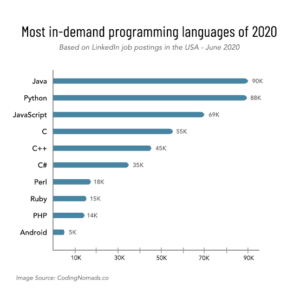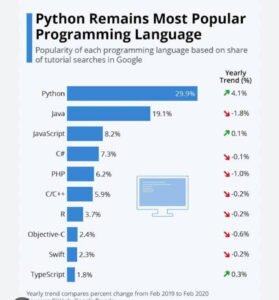Introduction
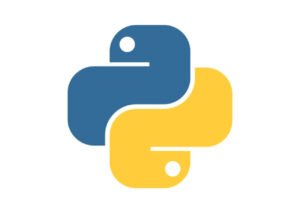
Python is a versatile and powerful programming language widely recognized in the tech industry for its simplicity and ease of learning. Developed in the late 1980s by Guido van Rossum, Python has emerged as a favored choice for both beginners and experienced developers alike, offering a vast array of applications and opportunities across various domains. This language’s design philosophy emphasizes code readability and simplicity, allowing developers to express concepts in fewer lines of code compared to other programming languages.
The syntax of Python is straightforward, which facilitates a smoother learning curve for individuals new to programming. Its resources, including extensive documentation and an active community, make it accessible for learners at different levels. Furthermore, Python supports multiple programming paradigms, including procedural, object-oriented, and functional programming, enhancing its adaptability for different use cases.
Python’s extensive libraries, frameworks, and tools further amplify its significance in the realm of software development. It has become a staple in data science, machine learning, web development, and automation, among other fields. The language’s compatibility with other platforms extends its functionality, empowering developers to create applications that seamlessly integrate with existing systems. Additionally, Python’s ability to work well with frontend frameworks and backend environments showcases its versatility, positioning it as an essential skill for modern developers.
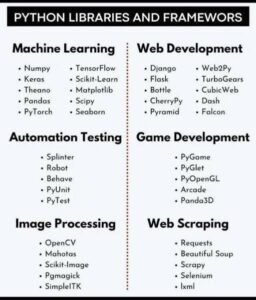
In summary, Python’s importance in the tech world cannot be overstated. Its ease of learning, design principles, and wide-ranging applications make it an ideal choice for anyone seeking to delve into programming or enhance their development skills. As we explore Python’s potential in frontend and backend development in subsequent sections, it becomes clear that this language is a vital tool in today’s technological landscape.
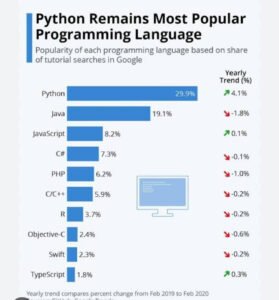
Frontend Development with Python
The realm of frontend development has traditionally been dominated by languages such as HTML, CSS, and JavaScript. However, Python has emerged as a viable option in web development through frameworks that allow developers to create dynamic and interactive user interfaces. Two of the most prominent frameworks in this ecosystem are Flask and Django. Both frameworks support the integration of Python with the conventional frontend technologies, facilitating the development of comprehensive web applications.
Flask, a lightweight framework, is often favored for microservices and small applications. It provides simplicity and flexibility, enabling developers to utilize Python’s robust features while also integrating templates that render HTML. Flask’s Jinja2 templating engine allows developers to embed Python code into HTML, making it easier to create dynamic web pages that can respond to user inputs. This functionality bridges the gap between Python’s backend prowess and the user-facing frontend, thus enriching the user experience.
On the other hand, Django offers a more comprehensive framework tailored for larger applications. With its batteries-included philosophy, Django provides a structured environment that facilitates rapid development. The Django templating system allows developers to create HTML files that can dynamically pull data from Python views. By employing Django’s features, such as forms and models, developers can seamlessly integrate Python logic into their web applications, enhancing interaction and responsiveness.
Furthermore, combining Python with JavaScript frameworks such as React or Vue.js can lead to even more dynamic applications. Python can serve as the backend API provider, while the frontend is handled by JavaScript, ensuring a smooth separation of concerns. This integration empowers developers to build robust applications that leverage Python’s capabilities while still delivering an engaging user interface.
In conclusion, Python in frontend development offers significant opportunities for developers looking to create dynamic and interactive user experiences. By effectively integrating frameworks like Flask and Django, along with traditional frontend technologies, the potential for crafting efficient web applications is considerably enhanced.
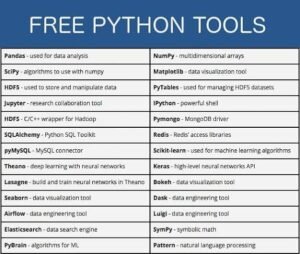
Backend Development with Python
Python has emerged as a preferred language for backend development due to its simplicity and versatility. It handles server-side programming effectively, allowing developers to focus on building robust applications without getting bogged down by complex syntax. When developing web applications, Python’s role is integral in managing the server’s logic and data processing, which directly impacts performance and user experience.
One of the key components of backend development in Python is the ability to create RESTful APIs. REST (Representational State Transfer) is an architectural style used for designing networked applications, and Python frameworks such as Django and Flask make it relatively straightforward to implement API functionalities. These APIs serve as intermediaries between the front end and the server, facilitating seamless data exchange and interaction. By leveraging these frameworks, developers can build scalable applications efficiently, catering to a wide variety of client requests.
Database interaction is another critical aspect of backend development, where Python excels. With libraries like SQLAlchemy for relational databases and Django’s built-in ORM (Object-Relational Mapping), developers can easily connect, query, and manipulate data. Python’s ability to integrate with various database types enhances the flexibility of applications, allowing developers to choose the best storage solution based on their specific requirements. Moreover, the language’s expressive syntax reduces the complexity often associated with database management tasks.
Frameworks such as Django and Flask not only simplify backend development but also empower developers to produce secure, maintainable code. Django, with its “batteries-included” philosophy, provides ready-to-use features such as authentication, URL routing, and admin interfaces, enabling rapid development cycles. Flask, on the other hand, offers the flexibility to choose the components required for your application, promoting a modular approach. This adaptability, combined with Python’s inherent scalability, positions it as a formidable choice for backend development in various projects, from simple web apps to large-scale enterprise solutions.
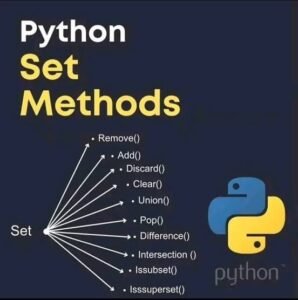
Python for Software Development
Python has increasingly emerged as a pivotal language in the realm of software development, owing to its versatility, ease of use, and rich ecosystem of libraries and frameworks. The python language is suitable for a myriad of applications ranging from simple scripts to complex, large-scale systems. One of the key benefits of utilizing Python in software development projects is its extensive library support. Python Libraries such as NumPy and Pandas facilitate data manipulation and analysis, while frameworks like Flask and Django offer robust solutions for backend development.
In the context of desktop application development, Python provides various tools such as Tkinter and PyQt, enabling developers to create user-friendly interfaces. These libraries seamlessly integrate with the core Python language, enabling rapid prototyping and development of applications that can run across multiple platforms, including Windows, macOS, and Linux. Furthermore, Python’s capabilities extend to automation scripts which aid in streamlining repetitive tasks. Automation scripts play a significant role in improving productivity and efficiency, allowing developers to focus on more complex challenges rather than mundane tasks.
Moreover, Python’s architecture supports the development of large-scale software systems, making it a go-to choice for many enterprises. Tools like Celery enhance task queues and enable asynchronous processing, while Docker can be utilized for containerization, further simplifying deployment processes. These practices not only aid in maintaining code quality but also enhance collaboration among teams. By adopting best practices such as version control with Git and continuous integration with tools like Jenkins, developers can significantly improve the software engineering process. Overall, Python’s adaptability and expansive toolkit solidify its position as a significant player in software development, ensuring that developers can deliver high-quality applications tailored to various needs.
App Development with Python
Python has gained significant traction as a versatile programming language, particularly in the realm of app development. Its simplicity and robust libraries make it an excellent choice for creating both mobile and desktop applications. Two prominent frameworks, Kivy and PyQt, have emerged as popular tools for developers aiming to build cross-platform applications efficiently.
Kivy is an open-source Python library that is specifically designed for developing multitouch applications. It supports a variety of platforms, including Windows, macOS, Linux, iOS, and Android, making it a powerful tool for those looking to create applications that can reach a wide audience. One of the standout features of Kivy is its ability to leverage GPU acceleration, which enhances the performance of graphical applications. Additionally, Kivy’s widget-based approach simplifies the design and layout process, allowing developers to create visually appealing and user-friendly interfaces with ease.
On the other hand, PyQt is another powerful framework that allows developers to construct applications for various operating systems. It provides bindings for the Qt toolkit, a well-known C++ framework, making Python applications capable of utilizing the advanced capabilities of Qt. With PyQt, developers gain access to a comprehensive set of features, including rich user interfaces and various tools that can help in rapid application development (RAD). This ease of use and flexibility makes PyQt a popular choice among developers for creating complex desktop applications that can run seamlessly on multiple platforms.
The combination of these frameworks highlights Python’s effectiveness in app development, making it not only accessible for beginners but also powerful enough for seasoned professionals. These tools significantly reduce the barrier to entry and facilitate the development process, enabling developers to focus on delivering functionality and enhancing the user experience in their applications.
Mathematics and Data Science with Python
Python has emerged as a dominant programming language in the fields of mathematics and data science, owing to its simplicity and extensive libraries that cater to various computational needs. In particular, libraries such as NumPy, pandas, and SciPy play crucial roles in enabling robust mathematical computations and efficient data analysis. NumPy, for instance, stands out for its capability to handle large multidimensional arrays and matrices, along with a comprehensive collection of mathematical functions to operate on these arrays. This library serves as the backbone for many other scientific computing libraries in Python.
On the other hand, Pandas is indispensable for data manipulation and analysis, providing data structures and operations for manipulating numerical tables and time series. With its functionalities, users can easily handle missing data, perform data aggregation, and manipulate datasets in ways that are straightforward and intuitive. The effectiveness of pandas significantly enhances the data-cleaning process, which is often a crucial step in preparing data for analysis.
SciPy complements these libraries by offering functions specifically tailored for scientific and technical computing. It enables users to execute complex calculations involving advanced mathematical concepts such as optimization, integration, interpolation, eigenvalue problems, and other finite-difference algorithms. This makes SciPy invaluable for data scientists and mathematicians alike, as it simplifies the execution of complex computations necessary for rigorous analysis.
Furthermore, Python’s versatility and ease of learning make it an attractive choice for those venturing into mathematics, statistics, or data science. The synergy of libraries like NumPy, pandas, and SciPy equips data scientists with powerful tools that can be seamlessly integrated to analyze large datasets and perform intricate mathematical calculations. As a result, Python not only streamlines the workflow for professionals in these fields but also empowers newcomers to develop their skills effectively. This combination of user-friendliness and robust functionalities underscores Python’s strength in mathematical and data science applications.
Learning Path for Aspiring Python Programmers
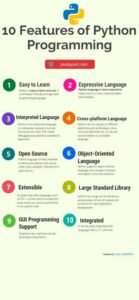
For those looking to establish a solid foundation in Python programming, the journey begins with understanding both the core language and its multitude of applications. Aspiring Python programmers should first familiarize themselves with the basic syntax and key concepts such as variables, data types, control structures, and functions. Numerous online tutorials and free resources like Codecademy or the official Python documentation are excellent places to start.
-
TimeIt can take 5–10 weeks to learn the basics of Python, but the time it takes depends on your experience with programming languages and related fields. It can take 1–3 months to learn the basics and 4–12 months to learn advanced topics.
-
CostThe cost of learning Python can range from free to thousands of dollars:
- Lower-cost: You can take self-paced classes or online courses.
- Immersive bootcamps: Can cost around $3,000–$5,000.
- University degrees: Typically cost more
Free: You can learn Python for free from online resources like:
- Noble Desktop: Offers a free Intro to Python Fundamentals seminar
- Learn Python.org: Offers a free interactive tutorial for those who already know how to code in another language
- Google for Education: Offers a free Python Class for people with basic programming skills
- Lower-cost: You can take self-paced classes or online courses.
As learners gain confidence, they should delve deeper into more advanced topics. It is crucial to explore object-oriented programming, data structures, and error handling, as these skills are foundational for both frontend and backend development. In addition, learning about frameworks such as Flask and Django for backend development can greatly enhance a programmer’s capability to build robust applications. For frontend development, understanding web technologies including HTML, CSS, and JavaScript, integrating them with Python-based frameworks, is vital.
Alongside theoretical knowledge, practical experience is indispensable. “Engaging in coding challenges through platforms like LeetCode or HackerRank helps sharpen problem-solving skills.”
Furthermore, building small projects can provide a practical application of the concepts learned. Projects can range from simple web applications to more complex systems that incorporate databases and user authentication, showcasing a well-rounded skill set.
For continuous learning and support, joining Python communities can be beneficial. Online forums such as Stack Overflow or Python-specific groups on Reddit allow programmers to exchange ideas, seek help, and collaborate on projects. Additionally, consider enrolling in structured courses offered by platforms like Coursera or Udacity for guided learning that often includes expert mentorship.
By following this learning path, aspiring Python programmers can steadily build proficiency, preparing them for exciting opportunities in both frontend and backend development.
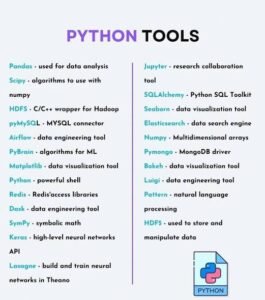
Global Demand for Python Programmers
The average salary for a Python developer in the UK is between £67,500 and £90,000 per year, depending on the source:
- DevITjobs.uk: The average salary is £69,000, with the median salary at £66,200. The bottom 25% of the market earn £52,500, and the bottom 10% earn £39,700.
- CW Jobs: The average salary is £67,500.
- Reed.co.uk: The average salary is between £90,000 and £100,000 per year.
- Glassdoor: The average salary in London is £57,158 per year, with an estimated total pay of £63,203 per year.
- Morgan McKinley: The salary in London is between £85,000 and £105,000 per year.
In the ever-evolving landscape of technology, the demand for Python programmers has surged significantly across various industries. Python, recognized for its versatility and simplicity, has become the language of choice for many developers, data scientists, and machine learning engineers.
This growing inclination towards Python is evidenced by job market trends which indicate an increasing number of openings requiring proficiency in the language. Companies are seeking skilled professionals who can leverage Python’s capabilities in different applications, from web development to data analysis.
Reports from prominent job platforms reveal that Python-related job postings have seen an upward trend, particularly in sectors such as finance, healthcare, and technology. The programming language’s role in data science is pivotal, as organizations prioritize data-driven decision-making. According to industry insights, data science roles that demand Python expertise are expected to grow by over 20% in the coming years. This growth is partly attributed to the prominence of big data and the extensive need for data visualization and analysis, wherein Python excels due to its rich libraries and frameworks.
Furthermore, in the realm of machine learning, Python continues to dominate due to its robust ecosystem of machine learning libraries like TensorFlow, Keras, and scikit-learn. Professionals well-versed in these tools find themselves at the forefront of this lucrative field, with average salaries reflecting this high demand. According to recent salary surveys, Python developers can expect competitive remuneration that often exceeds that of their peers working with other programming languages. This competitive edge emphasizes the significance of Python programming skills in securing favorable job opportunities in today’s market.
As technology continues to advance, the demand for Python programmers will likely escalate. With its applications spanning diverse domains, it remains a fundamental language for organizations striving to innovate and stay ahead. This trend showcases Python’s lasting impact on the global job landscape, making it an invaluable skill for both current professionals and aspiring developers.
Future Trends in Python Development
As the landscape of software development continues to evolve rapidly, Python stands at the forefront, adapting to the changing needs of developers and industries alike. One of the most significant trends shaping the future of Python development is the increasing integration of artificial intelligence (AI) and machine learning (ML) into various applications. Python has long been a favored language within these domains due to its simplicity, extensive libraries, and robust community support. Tools like TensorFlow and PyTorch are propelling advancements, making it easier for developers to leverage AI capabilities in their projects.
Moreover, the rise of data-driven decision-making has spurred the demand for data analytics, further solidifying Python’s role in data science. The language’s strengths in handling data manipulation and analysis, exemplified through libraries such as Pandas and NumPy, enhance its suitability for modern applications that require sophisticated data processing capabilities.
In addition to AI and machine learning, advancements in web technologies are influencing Python’s ecosystem. Frameworks like Django and Flask are continually evolving to accommodate the demands of modern web applications which require improved speed, security, and scalability. The rise of asynchronous programming and the use of WebSockets are anticipated to become commonplace, enabling developers to build real-time applications efficiently.
Another trend to consider is the proliferation of cloud computing, which is changing how applications are developed and deployed. Python’s compatibility with cloud services has made it a favorable choice for developing cloud-native applications. Moreover, as edge computing gains traction, Python’s role in processing data closer to the source is expected to expand, emphasizing the need for developers to harness performance optimizations while maintaining Python’s ease of use.
Ultimately, preparing developers for these evolving technologies and adopting a continuous learning approach will be crucial. As Python continues to grow and adapt, staying informed about emerging trends and advancements will empower developers to excel in an increasingly complex development landscape.
Conclusion
Throughout this exploration of Python, we have delved into its crucial role in both frontend and backend development. The language’s versatility and user-friendly syntax make it an essential tool for modern programming practices. From web development to data analysis, Python’s applications are extensive, enabling developers to build robust applications and systems efficiently.
One of the significant highlights of Python is the vast number of libraries and frameworks it offers. These tools facilitate various programming tasks and make it easier for developers to implement complex functionalities without reinventing the wheel. Whether utilizing Django for backend development or leveraging Flask for creating microservices, Python provides numerous solutions that cater to specific project needs. This adaptability has made Python particularly popular among developers, ensuring its continued relevance in the evolving tech landscape.
Moreover, Python presents a wide array of career opportunities for those pursuing a path in technology. Roles such as data scientist, web developer, and software engineer are just a few examples of how proficiency in Python can open doors in various sectors. The demand for skilled Python developers continues to grow, and this trend is expected to persist as more organizations recognize the benefits of employing Python for their projects.
Engaging with the Python community can provide additional insights and resources for personal and professional development.
Participating in forums, attending meetups, or contributing to open-source projects are all excellent ways to refine skills and expand one’s network.
By immersing oneself in this vibrant community, developers not only enhance their capabilities but also stay abreast of the latest trends and technologies that surround Python.
